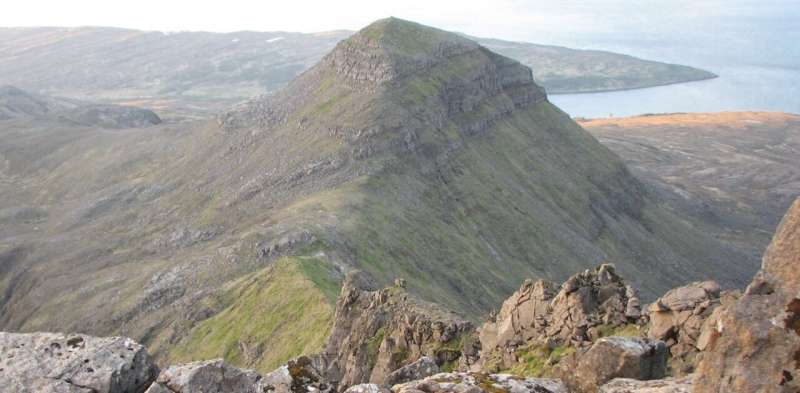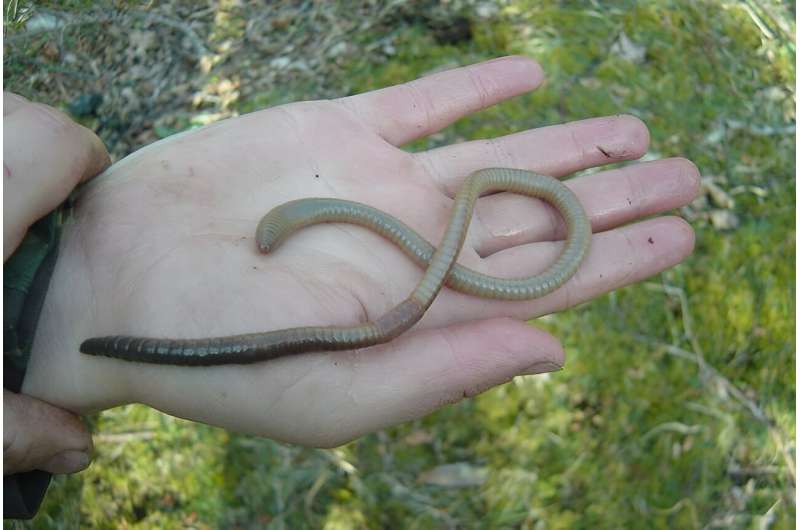The summit of Hallival is 723m above sea level. Credit: Kevin Richard Butt, CC BY-ND
Renowned for a thriving and intricately studied population of around 900 red deer, the Isle of Rum, part of Scotland's Inner Hebrides, is often considered an outdoor laboratory for scientific research. But the earthworms on Rum are equally remarkable. These invertebrates act as "ecosystem engineers", actively shaping the landscape, often after humans have left their mark on this remote island.
My investigations over 30 years have uncovered how people have influenced the current fragmented and uneven distribution, diversity and abundance of earthworms on this national nature reserve.
While taking my geography students on field trips to Rum in the mid-1990s, I realized there was scope for research on earthworm ecology. One of my Ph.D. students was studying soil development here and she quickly alerted me to differences in earthworm numbers found below different species of trees planted in the late 1950s. More worms lived below birch and oak trees than beneath pine trees or on unplanted moorland. This discovery spurred me into action.
Rum's human history goes back 9,000 years. Early humans came here to collect bloodstone, a flint-like mineral used to make arrowheads and other hunting or cutting tools. The island was deforested by early humans and the wet climate (with more than 2m of rain per year) led to the leaching of soil nutrients. The resulting poor-quality acidic soil supported moorland plants and low numbers of just three earthworm species.
If nothing else had happened to Rum soils, then this would be a very unexciting place to undertake research on earthworms.
But subsequent human inhabitants improved soils sufficiently to eke out a living as tenant farmers at a few locations around the coast. They used kelp seaweeds to fertilise the cultivated land and enrich soil quality. Then, some 200 years ago, these hardworking people were forcibly removed from their settlements on Rum (and much of Scotland) in the "Highland clearances".
At sites on Rum such as Harris, Dibidil and Kilmory, distinct ridges and furrows nicknamed "lazybeds" remain on the landscape. These indicate where the land was painstakingly dug by hand to grow potatoes and other crops. The furrows allowed drainage and the crops were grown on raised ridges. Two centuries since the last cultivation, these soils are still more fertile than surrounding areas, and they continue to support more earthworms.
At Papadil, another abandoned settlement, seldom visited these days, a brown forest soil has developed below stands of trees planted a century ago. Within these trees, colleagues and I found large earthworm burrows about 1cm in diameter. On an island with no badgers and no moles, a good supply of leaf litter for food and little disturbance from humans, we found the UK's largest Lumbricus terrestris ever reported in the wild.
At over 13g, some three times the normal weight for this species, these earthworms may have been up to ten years old. This really was an exciting find. We returned the worms to the soil—hopefully they have proliferated.
The Isle of Rum is home to the UK’s largest earthworms. Credit: Kevin Richard Butt, CC BY-ND
Wealthy owners of Rum treated this island as a shooting and fishing estate for more than a century and kept most people away from what became known as the "Forbidden Isle" during the late 19th- to early 20th-century.
When Kinloch castle was built by the textile tycoon George Bullough in 1897, his wife, Lady Monica wanted to grow roses in the garden. To facilitate this and generally improve the landscape, Bullough imported 250,000 tonnes of good-quality Ayrshire soil to spread around their new home. They lived in this castle for just six weeks each year, but this human opulence changed the underground ecosystem significantly.
The imported soil contained earthworms and this invertebrate community around the castle at Kinloch grew. Now, 12 species of earthworms—ones that prefer neutral pH soils—are present at high abundance (200 worms per square metre). Colleagues and I sampled at 50m intervals in altitude from here (at sea level) up to the summit of a steep, rocky peak called Hallival. Our research showed that this earthworm species richness and abundance ends abruptly at the wall around the estate—the limit of the imported soil.
Natural soil shapers
As well as human influences, natural processes can affect soil properties. On the slopes of Rum's peaks, many patches of bright green vegetation can be found among the rocks at elevations from 500-800m. These so-called "shearwater greens" are the result of nesting Manx shearwaters.
Pairs of these black and white seabirds burrow into the hillside to raise one chick each year, before beginning their long-distance migration towards South America. The verdant shearwater greens are fertilized from above by the feces of the adult birds before they fly off to forage for small fish such as herring and sprat to feed their chicks.
More nutrient-rich feces from the digested fish are also produced by the chicks in the burrow below ground, so soil enrichment is from a marine source. This supports grass growth and more earthworms—the same three species found on the moorland, but in much greater numbers.
On low-lying moorland, fenced plots keep deer away from trees that were planted in the 1950s and 1960s, just after Rum became a national nature reserve. Now, these protected trees provide roosts for songbirds, and the soil beneath them is rich with earthworms as the tree leaf litter adds nutrients to the soil. These plots have triggered a small-scale reafforestation project which could change this island landscape, its soils and its many earthworms.
Rum has yielded some remarkable earthworm findings, often linked to human activities or dynamic natural processes. As earthworms engineer this ecosystem and naturally derived nutrients get added, soils change. Longterm monitoring on Rum could help us better understand landscape transformations and soil health, here and elsewhere.
Provided by The Conversation
This article is republished from The Conversation under a Creative Commons license. Read the original article.![]()

























